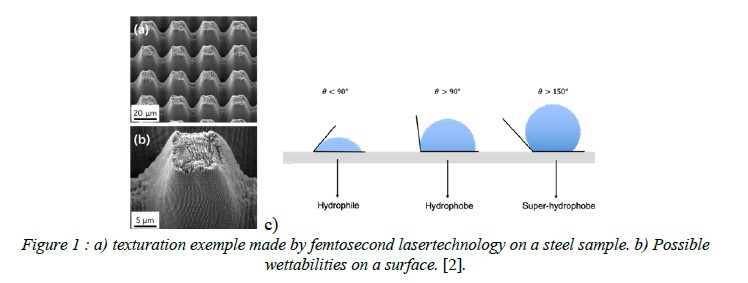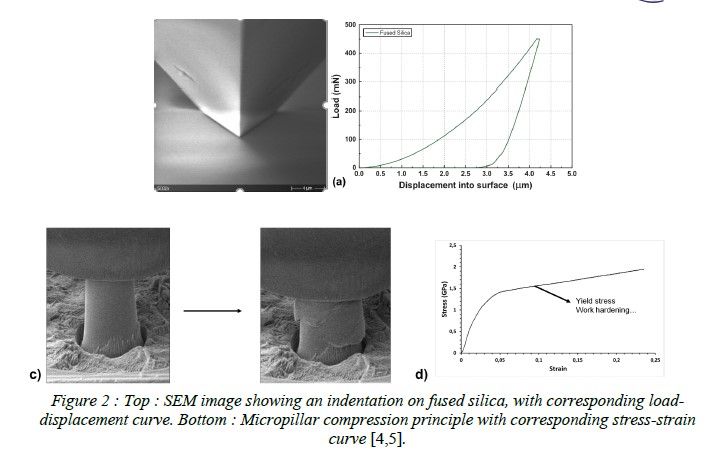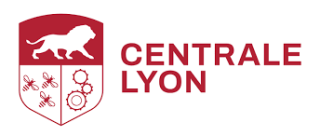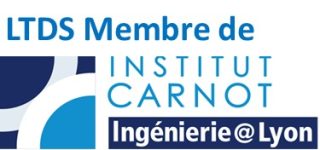Mechanical properties of textured surfaces through micromechanical testing
Subject:
Textured surfaces play an important role in industry, particularly because these surfaces provide new functionalities, such as surface’s wettability modification, or serving as a lubricant reservoir to reduce wear in industrial contacts. A process that allows for rapid surface texturing at the micrometric, or nanometric scale, is femtosecond laser technology [1].
Recently, surfaces textured by femtosecond laser (Figure 1a) have demonstrated the ability to create superhydrophobic surfaces (Figure 1b), enabling water repellency on these surfaces, and making them attractive for numerous industrial applications. However, the durability of these textures has not been deeply studied.
This is due to the need for specific micromechanical tools to characterize them, as the texture dimensions are on micrometers or even nanometers range.

For about ten years, a new technique for measuring micromechanical properties has been developed, based on in-situ micromechanical tests under a Scanning Electron Microscope (SEM). The principle consists in using a micromechanical device, installed inside an SEM, the SEM technology enabling the precise positioning of the mechanical tool in front of the micro-sample to be characterized. An example is presented in Figure 2, showing a micropillar compression test and a nanoindentation test under SEM [3,4].
Thus, the objective of this Master’s internship project consists in measuring and understanding the micromechanical properties of these textures through in-situ tests under SEM. These mechanical properties will be compared to those of the non-textured material.
After conducting an initial literature review on textured surfaces, femtosecond laser technology, and micromechanical methods, the intern will be able to perform micromechanical tests on both textured and non-textured surfaces. Indentation tests will be carried out first, as this method is commonly used in the laboratory with the available in-situ indenter. Depending on the results, other types of micromechanical tests will be considered, such as micropillar compression, scratch tests, or even fracture tests of structures.

This work will be carried out at LTDS. This internship offers the opportunity to write a scientific article and to continue with a PhD thesis. The candidate has to send his CV, cover letter, and transcripts to Gaylord Guillonneau (gaylord.guillonneau@ec-lyon.fr) and Stéphane Valette (stephane.valette@ec-lyon.fr).
Desired education: Engineer in Materials Science / Mechanical Engineering, Master of Science in Materials Engineering, Mechanics, Physics Skills developed: Contact mechanics, instrumentation, surface analysis, materials science, autonomy, presentation of results
Contract & Salary: Centrale Lyon / around €550 net per month
Location: LTDS, École Centrale de Lyon in Ecully
Internship duration: 5-6 months between February and September 2025.
Contacts, supervisors:
G. Guillonneau, e-mail: gaylord.guillonneau@ec-lyon.fr
S. Valette, e-mail : stéphane.valette@ec-lyon.fr
[1] J. Bonse, S.V. Kirner, J. Krüger, Laser-Induced Periodic Surface Structures (LIPSS), in: K. Sugioka (Ed.), Handbook of Laser Micro- and Nano-Engineering, Springer International Publishing, Cham, 2021: pp. 879–936. https://doi.org/10.1007/978-3-030-63647-0_17.
[2] S. Basset, Superhydrophobie durable d’une surface métallique par texturation de surface : développement de méthodes industrialisables pour des applications EDF, These de doctorat, Ecully, Ecole centrale de Lyon, 2022. https://theses.fr/2022ECDL0028 (accessed October 2, 2024).
[3] R. Rabe, J.-M. Breguet, P. Schwaller, S. Stauss, F.-J. Haug, J. Patscheider, J. Michler, Observation of fracture and plastic deformation during indentation and scratching inside the scanning electron microscope, Thin Solid Films 469–470 (2004) 206–213. https://doi.org/10.1016/j.tsf.2004.08.096.
[4] G. Guillonneau, J.M. Wheeler, J. Wehrs, L. Philippe, P. Baral, H.W. Höppel, M. Göken, J. Michler, Determination of the true projected contact area by in situ indentation testing, Journal of Materials Research 34 (2019) 2859–2868. https://doi.org/10.1557/jmr.2019.236.
[5] H.H. Ding, V. Fridrici, G. Guillonneau, S. Sao-Joao, J. Geringer, J. Fontaine, P. Kapsa, Investigation on mechanical properties of tribofilm formed on Ti–6Al–4V surface sliding against a DLC coating by nanoindentation and micro-pillar compression techniques, Wear 432–433 (2019) 202954.
https://doi.org/10.1016/j.wear.2019.202954.




